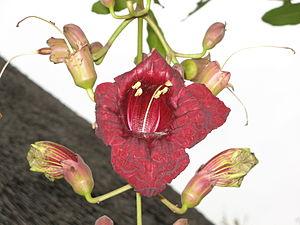A Sausage Tree or scientific name as Kigelia africana is native in South Africa. It is very poisonous to eat.
Kigelia is a genus of flowering plants in the family Bignoniaceae. The genus comprises only one species, Kigelia africana, which occurs throughout tropical Africa from Eritrea and Chad south to northern South Africa, and west to Senegal and Namibia. The Kigelia grows a fruit that grows up to 2 feet long, weighs about 15 lbs, and looks like sausage.
Etymology




The genus name comes from the Mozambican Bantu name, kigeli-keia, while the common names sausage tree[1] and cucumber tree[1] refer to the long, sausage-like fruit. Its name in Afrikaans worsboom also means sausage tree, and its Arabic name means "the father of kit bags" (Roodt 1992).
Growth
It is a tree growing up to 20 m (66 feet) tall. The bark is grey and smooth at first, peeling on older trees. It can be as thick as 6 mm on a 15-cm branch (Roodt 1992). The wood is pale brown or yellowish, undifferentiated and not prone to cracking (Roodt 1992).
The tree is evergreen where rainfall occurs throughout the year, but deciduous where there is a long dry season. The leaves are opposite or in whorls of three, 12 to 20 inches (30–50 cm) long, pinnate, with six to ten oval leaflets up to eight inches (20 cm) long and 2.25 inches (6 cm) broad; the terminal leaflet can be either present or absent. The flowers (and later the fruit) hang down from branches on long flexible stems (2-6 metres long). Flowers are produced in panicles; they are bell-shaped (similar to those of the African tulip tree but broader and much darker and more waxy), orange to maroon or purplish green, and about four inches (10 cm )wide. Individual flowers do not hang down but are oriented horizontally. Some birds are attracted to these flowers and the strong stems of each flower make ideal footholds. Their scent is most notable at night indicating that they are adapted to pollination by bats, which visit them for pollen and nectar. They also remain open by day however, and are freely visited by many insect pollinators, particularly large species such as carpenter bees.
The fruit is a woody berry from 12 to 39 inches (30–100 cm) long [2] and up to seven inches (18 cm) broad, but eight inches (20 cm) has been reported. [3] Typically it weighs between 11 and 22 pounds (5 and 10 kg) but occasionally up to 26 pounds (12 kg)[4], and hangs down on long, rope-like peduncles. The fruit pulp is fibrous and pulpy, and contains numerous seeds. It is eaten by several species of mammals, including baboons, bushpigs, savannah elephants, giraffes, hippopotamuses, monkeys, and porcupines. The seeds are dispersed in their dung. The seeds are also eaten by brown parrots and brown-headed parrots, and the foliage by elephants and greater kudu (Joffe 2003; del Hoyo et al. 1997). Introduced specimens in Australian parks are very popular with cockatoos. The trees are also found in large numbers in Ingraham Institute NH-24 campus, Ghaziabad, Uttar Pradesh in India. Whether it is the same species has not yet been verified.
Cultivation and uses
The fresh fruit is poisonous and strongly purgative; fruit are prepared for consumption by drying, roasting or fermentation (Joffe 2003; McBurney 2004). In central Kenya, the dried fruits are used to make an alcoholic beverage called Muratina which is a core components in cultural events in Central Kenya. Kigelia is also used in a number of skin care products. In Botswana, the timber is used for makoros, yokes and oars (Roodt 1992).
The tree is widely grown as an ornamental tree in tropical regions for its decorative flowers and unusual fruit. Planting sites should be selected carefully, as the falling fruit can cause serious injury to people and damage vehicles parked under the trees.
Vernacular names
In Kikuyu: Template:Lang;[5] Swahili: mbungati, mwegea, mnyegea, mvongonya;[6] Hindi balam kheera, hathi bailan; Luo yago; Malayalam shiva kundalam; Tamil yaanai pudukan; and Yoruba pandoro. Tugen(kalenjin tribe): Rotinwo
See also
- [[]]
- [[]]
- [[]]
External links
- [www.bbc.co.uk]
- ↑ 1.0 1.1 Sangita Saini, Harmeet Kaur, Bharat Verma, Ripudaman, and S. K. Singh (2009). "Kigelia africana (Lam.) Benth. — an overview". Natural Product Radiance 8 (2): 190–197.
- ↑ Huxley, Anthony. The New Royal Hort. Soc. Dictionary of Gardening. 2. New York: Stockton Press. p. 735.
- ↑ Lindley, John and Thomas Moore (1866). A Treasury of Botany. 2. London: Longmans, Green & Co.. p. 647.
- ↑ Vandaveer, Chelsie (March 7, 2002). "Killer Plants".
- ↑ Kamau, Loice Njeri et al. (2016). "Ethnobotanical survey and threats to medicinal plants traditionally used for the management of human diseases in Nyeri County, Kenya", p. 6.
- ↑ Standard Swahili Dictionary Oxford University Press, date unknown